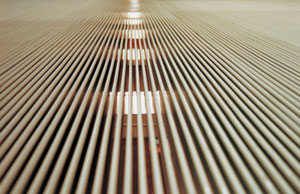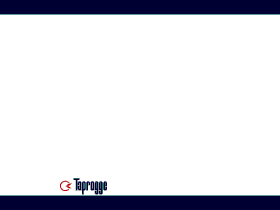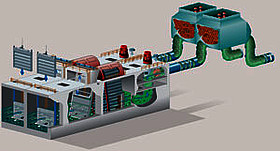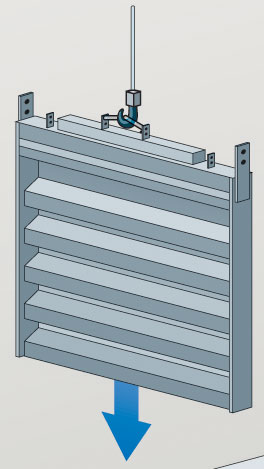Pre-screening systems are the bridge between nature and technology for many industries. They form the first link in the chain of conversion from natural water to industrial utilization.
For many years they represented the only place where industrial cooling water circuits were cleaned. But the growing know-how of the economic benefits through improved water cleaning, and higher quality demands upon industrially utilized water, have changed those systems considerably.
TAPROGGE has been playing a decisive role in this development, above all through the major technical progress of the filtering technology installed downstream, and is today able to offer IN-TA-CT®, a modular planning scheme for the overall solution of the water-technological tasks in this field. The solutions have been developed by starting from an integral, all-embracing consideration of the purifying task for the individual objects to be protected.

- All-embracing purifying solution
Field of Application
- Application in sea, brackish, river water and other types of surface water for the protection from macro fouling of pumps installed downstream
- Pre-screening stage in main and auxiliary cooling water circuits of power stations, chemical and petrochemical plants, steel works, and other industrial applications
The Tasks of Pre-screening Systems in Changing Times
After decades of traditional utilization, pre-screening systems have been subject to a historical change particularly in recent years. Reasons:
- progressing capacity of filtration technology installed downstream for the solution to problems of macro fouling in pipes after the pre-screening system
- changed environmental demands
TAPROGGE has had an important share in this change and elaborated a new planning approach with IN-TA-CT®. The technical change has taken place in three main phases:
Up until the late 60s, the complete cleaning chain of major pre-screening systems, above all in cooling water circuits, consisted of a multi-stage, mechanical treatment with
- coarse bar screens
- fine bar screens
- travelling band screens or drum screens.
Installed in the pump receiver and isolated from the water intake by stop logs, pre-screening systems had to provide an overall and final protection from coarse debris to the components of the cooling water system installed downstream. Components of a cooling water circuit in need of protection are:
- cooling water pumps
- condensers and heat exchangers in main and auxiliary circuits
It turned out in many places, however, that travelling band screens or drum screens, due to their arrangement upstream of the pumps, could not effectively avoid the obstruction of tube sheets of heat exchangers, even if smallest mesh sizes with perforations of down to 1 mm were used. Reasons:
- Ingress of mussel larvae and other organisms still in embryo, which cannot be removed by travelling band screens. They settle on the walls of the cooling water pipes, grow up into colonies, are detached by the cooling water flow and clog objects installed downstream.
- Undesired ingress of large debris volumes into the open safety flaps provided as a self-protection of the travelling band screens
- Undesired transport of debris particles from the debris-loaded to the cleaned water side, a phenomenon happening with travelling band screens with lateral flow ("carry-over effect")
- Undesired ingress of debris particles through worn sealing at the long guide rails of the movable parts of travelling band screens and drum screens (often identified very late)
- Maintenance intensity and susceptibility to repair
Phase 2
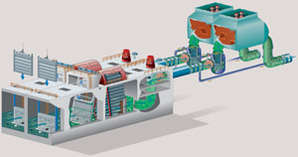
- Cooling water system with turbulence filter
With the development of a voluminous turbulence filter in the late sixties TAPROGGE created a principal solution to the deficiencies of the travelling band and drum screens as heat exchanger protection, which since then has had a great influence on the fundamental concept of mechanical cooling water cleaning.
The basic innovation was to place this filter immediately upstream of the heat exchanger to be protected. In such an arrangement, which means in addition to the rakes and travelling band and drum screens, macro fouling could for the first time be effectively mastered on the total distance of the pipe, from the pre-screening system to the heat exchanger. Within a few years more than 700 installations of this filter type in major cooling water cycles the world over made this technical concept the world standard.
Phase 3
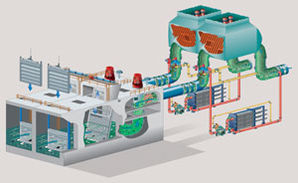
- Modified pre-screening system combined with high performance filters
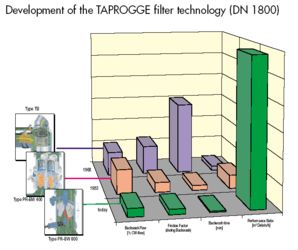
- Development of the TAPROGGE filter technology (DN 1800)
The disadvantage of the turbulence filter was that its high space requirement often rendered a retrofit into existing plants impossible. In the eighties TAPROGGE again succeeded in developing a new world standard of compact high performance debris filters by changing the technical concept from the voluminous storage filter to the principle of "pressure-relieved backwash" (PR-BW).
PR-BW filters of this generation are not only easy to retrofit but also far exceed the performance rates (debris discharge capacity) of space-intensive travelling band screens / drum screens.
With the performance of this filter class TAPROGGE opens up to the architect engineer / operator a further potential of optimization for the arrangement of the pre-screening chain in cooling water circuits: Now that the better located and more effective filters can take over the protection of the heat exchangers connected downstream, the pre-screening systems can concentrate on the pump protection. For this task, however, only coarse bar and fine bar screens are required, thus the capital cost is considerably reduced.
TAPROGGE's Concept for Pump Protection
With a two-stage cleaning chain of coarse bar and fine bar screens and stop logs for isolating purposes connected upstream, TAPROGGE designs and supplies a modified pre-screening system which meets the requirements of modern pump protection.
In combination with the TAPROGGE high performance filters of the PR-BW series (e.g.: filter type PR-BW 800), an overall solution for the protection from macro fouling of pumps and heat exchangers or condensers connected downstream is created that is much more effective than before.
This concept offers great advantages to the user:
- Travelling band or drum screen costs including construction costs are saved - and the capital cost considerably reduced.
- Better effectiveness and reliability of the cleaning task by more appropriate location and upgraded performance of the components of the entire system. Thereby the availability is increased.
- Supply from a single source. Without interfaces, and inclusive of the TAPROGGE system guarantee.
System Components
Stop Logs
Task:Stop logs serve as primary shut-off means of the intake channel for the pre-screening systems. As such they enable the inspection and maintenance of coarse bar and fine bar screens located downstream.
Arrangement:
For the guidance of the stop logs, guideways are provided for in the concrete at the bottom and the walls of the channel. Sealing is ensured by a circumferential neoprene profile. Lowering and lifting of the stop logs is accomplished by means of a lifting beam which introduces the stop log into the guideway by means of a crane. Depending on the available length of the guiding frame, the stop log, unless required for shut-off purposes, can be parked in the upper part of the guiding shaft.

- Stationary coarse bar screen

- Traversing skip-raked machine
Coarse Bar Screen
Task:The coarse bar screen forms the first stage of the mechanical water treatment for the pump protection. It is meant to retain large, voluminous debris.
Screening grade:
The clearance between the screen bars is regularly selected between 80 and 100 mm.
Function:
Depending on the volume of debris to be expected, the coarse bar screens are cleaned either manually, or automatically by a traversing skip-raked machine.
Alternatively to the stop logs, manually cleanable bar screens are located in the same guideways as used for the stop logs. For cleaning purposes the bar screens are lifted by a lifting beam and debris is manually removed in an appropriate place.
In the automatic cleaning mode, skip-raked machines as described for the fine bar screens are used.
Skip-Raked Fine Bar Screen

- Skip-raked fine bar screen with rake carriage
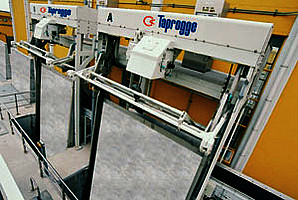
- Survey of skip-raked fine bar screen
Task:The fine bar screen forms the last stage of the mechanical water treatment chain upstream of the pumps and protects the same. Due to the small clearance of its gaps which indicates a high screening volume, automatic stationary skip-raked machines are regularly provided for.
Grade of filtration:
For effective pump protection bar clearances from 10 to 40 mm are recommended. Depending on the impeller size of the pump connected downstream, bar clearances of
- 20 – 40 mm for main cooling water circuits
- 10 – 20 mm for auxiliary cooling water circuits
have proven reliable. The final bar clearance is determined according to the relevant project.
Function:
Water flows through the gaps of the fine screen, with debris larger than the gap width being retained. Once a pre-set level differential across the bar screen has been reached, or initiated by a timer or manually, the clam-shell shaped rake carriage travels in open condition from its top (= idle) position down to the channel bottom guided by lateral rails. At the lowest position the rake carriage closes and, with its rake comb, penetrates into the gaps of the screen. Due to its large opening angle it is even able to pick up debris accumulated in front of the bar screen. Upon passing through the air-water level the rake carriage reaches an automatic scraper above floor level which discharges the debris from the rake carriage into a container or a gutter.
Technical Features and Benefits

- Control of skip-raked fine bar screen
- A special three-rope technology enables the individual opening and closing of the rake carriage during ascending and descending travel. If debris that has got stuck in the screen disturbs the travel of the rake carriage, repeated cleaning allows a removal of the cause of disturbance.
- A partial perforation of the carriage shell makes sure that the "surge effect" temporarily created in the ascending motion when passing the water-air level does not cause the debris to be flushed off with the surging water.
- According to the debris load and the cleaning frequency resulting thereof, also rail-guided traversing machines can be used instead of the stationary version, particularly if several intake channels are prevalent. This saves capital cost. For security reasons the number of intake channels per traversing machine should be limited to a maximum of three.
